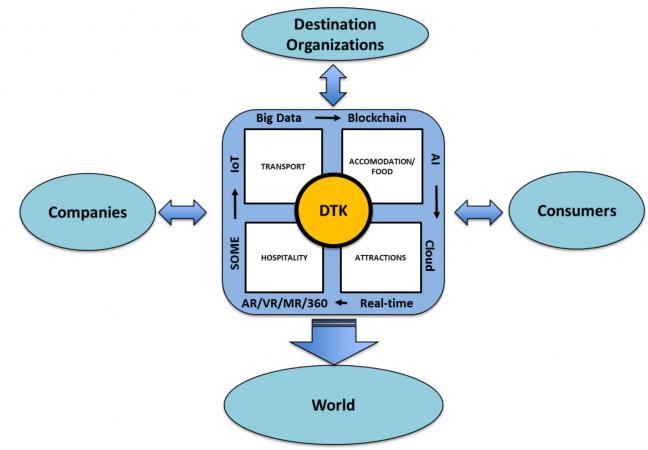Imagine that you, as a destination marketing manager, have a crystal ball where you can see where the visitors have been, where they are at the moment and where they are going. What a tool for planning and development – transportation optimization, overtourism mitigation, safety and security issues and tourist experiences facilitation – we are talking about a digital twin.
A digital twin is a digital replica, a virtual representation of a physical object or a process, a digital aid companies can use for product development and test, and to monitor their products’ performance in real time. In comparison to CAD and blended spaces (Ayan & Benyone, 2013), the digital twin has, at least, two benefits. First, the digital twin represents a one-to-one connection between the real and the virtual reality. Second, it is dynamic and generates real time data using sensors and automated information sharing processes. Being an extension and consequence of the Industry 4.0 discourse, the digital twin offers business value by being the tool managers can use to reduce time to market for a new product, predict and detect quality defects, and improve on-time maintenance services (Tao, Cheng, Qi, Zhang, Zhang & Sui, 2018). Just to mention a few benefits.
In comparison to the development of digital twins for the manufacturing industry, the discussion of dynamic virtual representations of services and destinations is emerging. The three year tourism development and research project “Destination Kvarken” that Hanken and the Department of Marketing are involved in, started in August 2018, with one of the sub-goals to develop a digital platform for the Kvarken region, including Vasa (and neighbor communities) in Finland, and Umeå (and neighbor communities) in Sweden, and the transportation in between the two countries (today operated by Wasaline). This gave us a reason to draft an architecture for a “Digital Twin Kvarken”, being painfully aware of the fact that there is a huge discrepancy between theory (what we would like the virtual representation to be) and practice (what it will be), especially in business settings dominated by small and micro firms (with limited resources). However, let us not be depressed.
With a focus on tourist experience, applying an end-user perspective, there are four main components or resource areas which have to be in place, on a destination. In our digital twin architecture, these components are separate but integrated experience areas and information networks, encircled by processes, which create, communicate, aggregate and analyze digital data (Figure 1).

Figure 1. Digital Twin Kvarken (DTK) Architecture
Tourists need a “reason to go” which can be defined as attractions. Furthermore, transportation to and within the destination has to be planned and managed. For overnight guests, people need accommodations and restaurant services. Finally, hospitality based on a welcoming attitude, in the society at large, has to be cultivated.
Based on existing digital maps, GPS technologies, blended spaces, and available information from the “Visit” organizations of Vaasa and Umeå, a silhouette of a “Digital Twin Kvarken” can be discerned. One can, as a platform for the development, identify a M2M2P (machine-to-machine-to-people) structure geared by big data. However, more real-time information (big data) is needed at the moment, and the two critical questions are: what information is needed, and how to get it? But not only that, it can also be assumed that different stakeholder groups (companies and destination organizations, and other, we call them the “World”) want the digital twin to appear differently to fit their particular needs, to be useful. Consequently, an unanswered research question is also the visual presentation. How should the Digital Twin Kvarken present itself?
When all is set and done, how can a digital twin be used for destination development and management? With analytics of different types (descriptive, diagnostic, discovery, predictive and prescriptive) creating hindsight, insight and foresight, DMOs, for example, can continuously plan for and monitor transportation and safety issues on a destination. Let us assume that for a particular weekend several big events are taking place, in the city of Vaasa. This can be simulated, and to attain the best visitor experience all kind of congestions are to be avoided, and different types of traffic arrangements coordinated and planned for.
References
Ayan, S. & Benyon, D. (2013): Designing Blended Spaces: Historical Echoes, Testing a Framework for Digital Tourism. The International Journal of Architectonic, Spatial and Environmental Design, Vol. 7, No. 2, pp. 1–18.
Industry 4.0 and the digital twin. Manufacturing meets its match. Deloitte University Press. https://www2.deloitte.com/content/dam/insights/us/articles/3833_Industry…
Industry 4.0 – Opportunities and Challenges of the Industrial Internet. https://www.pwc.nl/en/assets/documents/pwc-industrie-4-0.pdf
Tao, F., Cheng, J., Qi, Q., Zhang, M., Zhang, H. & Sui, F. (2018): Digital twin-driven product design, manufacturing and service with big data. International Journal of Advanced Manufacturing Technology, Vol. 94, No. 9–12, pp. 3563–3576.
